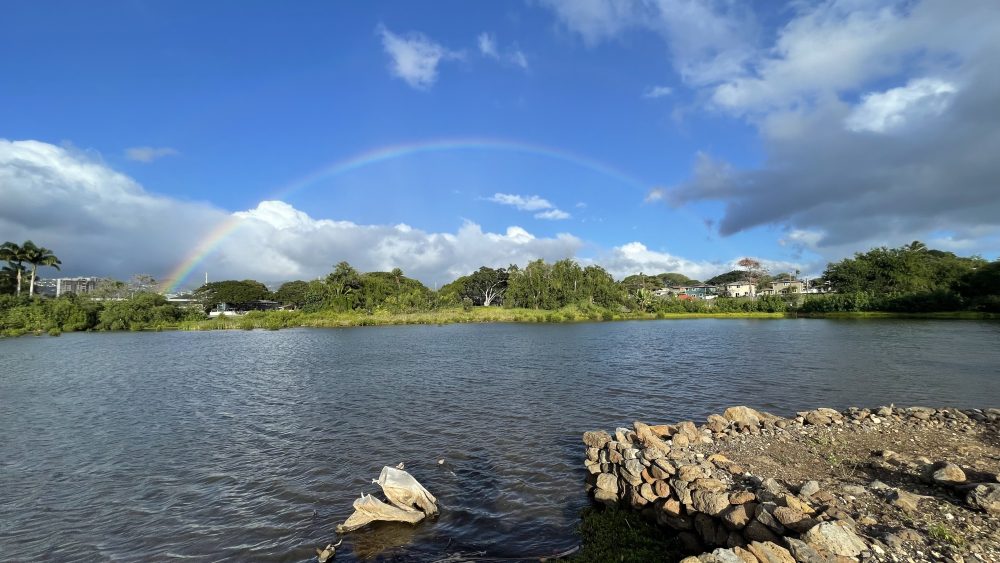The shores of Pearl Harbor were once lined with nearly two dozen rock-walled fishponds, some so old that they were believed to be built by the gods. The structures became a symbol of Native Hawaiian ingenuity and provided an environmentally sustainable supply of fish, shellfish, and other sea creatures. They were not only a source of food but also a place of spirituality and healing.
Yet, after centuries of degradation, most of these sacred sites have disappeared. One of the few that remains is Loko Iʻa Pāʻaiau, also known as the Royal Fishpond of Queen Kalanimanu‘ia, a site buried beneath invasive mangroves until a naval archaeologist uncovered it ten years ago.
To restore the royal fishpond to its former glory, the U.S. Navy partnered with the Living Life Source Foundation, Ali’i Pauahi Hawaiian Civic Club, and Nalima No’eau, which is memorialized in a Memorandum of Understanding. Over 10,000 volunteers from civic groups, local schools, and the community have joined the effort. Over time, endangered and endemic species have slowly begun to return, including the pearl oysters that give the region its name. Many volunteers come back again and again, saying that the practice of reviving the site lifts their spirits.
“The fishpond, as a sacred site, is ideal to explore the connection between outer and inner restoration and healing,” said Thao Le, a psychologist, public health, and behavioral sciences trained researcher and professor at the University of Hawaiʻi Mānoa. With the support of a Burroughs Wellcome Fund Climate Change and Human Health Seed Grant, Le was given permission by her native Hawaiian collaborators to explore how this external ecological restoration project supports internal mental health and wellbeing.
Reclaiming history
Loko Iʻa Pāʻaiau was built during the reign of Mo‘i Wahine Kalanimanuia, a benevolent figure who ruled over the island of O‘ahu during the 1400s. After contact with the West, the royal fishpond fell into disrepair, suffering from colonialization, pollution, and development effects. The attack on Pearl Harbor cut off public access to the site. Unchecked, invasive mangroves spread throughout the area.
In 2014, Navy archaeologist Jeff Pantaleo had a project come across his desk from the Natural Resources Program, which was tasked with clearing all the mangroves around Pearl Harbor. While reviewing cultural resources, he came across an old record of the royal fishpond. He never knew it existed and went into the field to investigate. “It was very dense vegetation, so I crawled around with my machete, and I found the walls or what looked like the walls,” he recalled. “That’s how I knew the fishpond was still there.”
Pantaleo reached out to Native Hawaiian leaders to see if they would be interested in helping to restore and maintain the site. Approximately 100 members of the community responded with an enthusiastic yes. Among them was “Uncle” Bruce Keaulani, a widely respected indigenous practitioner and CEO of Living Life Source Foundation, a local nonprofit that provides traditional healing services. “Uncle is one of the few keepers of the traditions and the old ways,” said Le, who has developed a close relationship with the elder over the years. “He is so humble and quiet and has this tremendous wisdom and patience. He cares about healing not only the fishpond but also our relationships and ourselves.”
Emotions and values
Today, the fishpond is a recognized historical site, a cultural destination, and a work in progress. Throngs of volunteers continue the back-breaking work of removing mangroves, pickleweed, and other invasive species, as well as reconstructing the ancient fishpond wall. Restoring the fishpond has become a way to practice Hawaiian values, such as ‘ohana (family), kuleana (responsibility), and aloha (love). According to Le, these kinds of values can protect against depression and loneliness, whereas self-serving values (such as hedonism, power, and achievement) can be particularly detrimental to youth mental health.
Le wondered whether the very act of restoring the royal fishpond, when paired with the principles of traditional ecological knowledge, could serve as a source of psychological and emotional well-being for indigenous youth. She collaborated with Shawn Patrick Kalani (Kumu Keola), who teaches Hawaiian language and Hula at a local high school, and ten students agreed to participate in the intensive project, which involved 400 hours volunteering at Loko Iʻa Pāʻaiau.
The place-based intervention involved teaching the students about the history of the fishpond, its cultural significance for Native Hawaiians, Native Hawaiian terms related to various elements at the fishpond, cultural protocol for entering the fishpond, and Native Hawaiian values, etiquette, and aloha mannerisms (such as gentleness and kindness) related to restorative practices. The researchers collected data on the students’ emotions and values, surveying them before and after each weekly session at the fishpond as well as conducting pre- and post-focus group sessions.
“I think we’re very much driven by our emotions, and I’ve always been interested in how our values inform our emotions and vice versa,” said Le. She was curious to see if the youth developed and deepened Native hawaiian values as they went through the year-long intensive program. In addition, she wanted to know what impact the experience had on their emotional state.
The importance of place
The findings, published recently in the journal Children, Youth and Environments, revealed gains in positive emotions and mental states, with happiness and focus being the most salient.
“Even the kids who came in complaining that they didn’t want to be there on some afternoons or Saturdays came out of the experience feeling happy, energetic, and engaged,” said Le. “Restoring the fishpond was a lot of work, but it gave them meaning and purpose, and forced them to think beyond themselves.”
The study underscored the connection between valuing sacred land and character growth. It also showed how Pāʻaiau could serve as a source of peace and healing for students. Students said that they plan on returning to the fishpond throughout their lifetimes. “There will never be a time when you’re here that, like, when you leave you’re gonna be in a bad mood,” one student said. “There’s something about this place,” said another.
Le believes that the students’ responses to the project demonstrated the power of place-based education to reinforce the reciprocal relationship between ecological and human health and wellbeing.
“I think we have fewer and fewer spaces in our environment that are just quiet and peaceful,” she said. “In the indigenous culture, there’s always been places of refuge. I think we still need sacred places where you can just come and sit and reflect.”
To share that feeling with others, she and Uncle Bruce co-authored a children’s book about the royal fishpond called Ho’oponopono is Harmony. The publication was supported by the Department of Health and Human Services, which has already sponsored 1800 copies to be distributed to youth across Hawaii.


Comments are closed.